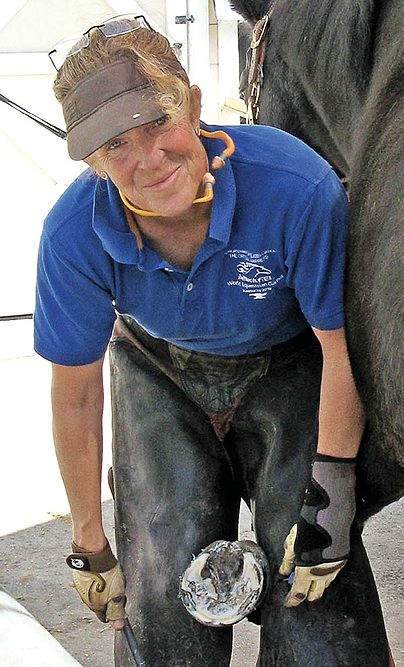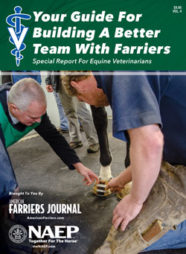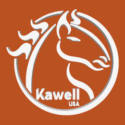There are a lot of costs for any footcare business. Materials, insurance taxes and so on. But which is the most significant cost? California farrier Margie Lee-Gustafson believes it is what you pay yourself. Without paying yourself first, you may not be earning your full potential
In a presentation at the 2018 American Farrier’s Association (AFA) Convention in Reno, Nev., Lee-Gustafson shared her exercise in determining what to charge per horse. It relies on you understanding and honestly factoring in each cost your business incurs.
Where to Start: Pay Yourself First
Table 1 shows the various steps in the cost analysis exercise. Lee-Gustafson says the first step in this exercise is to pay yourself a salary. For her plan, the past AFA president created a scenario of a farrier who wants to earn $60,000 per year ($5,000 per month). The scenario factors in shoeing five horses per day, working 5 days a week.
Farrier Takeaways
- The most important step in determining your costs per horse is paying yourself first.
- Be honest and thorough in analyzing your own costs.
- Factor in wellness programs and continuing education in your costs to ensure a long career.
Of course farriers should pay themselves for vacation, holidays and other time off. Lee-Gustafson factors there are eight traditional holidays, 5 days off for continuing education, miscellaneous personal days and vacation days. Together with the weekends, she uses 234 working days per year in the exercise. This comes out to about 49 working weeks per year. The purpose was to illustrate the process, so your circumstances and results will vary.
“Can you work 52 weeks straight and sustain a healthy body and a balanced lifestyle?” she asks. “This is a more realistic estimate of what your body could take over a 20- to 30-year shoeing career.”
With this in mind, Lee-Gustafson says based on the outlined factors (five horses per day over 234 working days), this salary goal requires $51.28 per horse in net revenue.
Lee-Gustafson shows that over 5 days a week for 52 weeks per year — entirely not healthy for career longevity — the price per horse for the salary goal is $46.15. Although the math is simplified in this exercise, the point is made — raising the prices by $5 per horse results in paid time off, rather than a schedule that will destroy you physically and mentally over a 30-year career.
The Cost of Your Materials
Next, determine your cost of materials for shoeing each horse. Again, this is an exercise in understanding the costs for your practice and considerations required. Variations will affect this for your practice, such as the type of horses and their footcare requirements. You also need to factor in sales tax, and less tangible estimations on the wear and tear of your tools and equipment. You must be thorough in thinking about each expense you incur for materials.
“If you don’t have a local supply house, you’re going to have to add shipping costs to those materials,” she says. “Our supplies are dropped off for free. And then you need to consider all of these costs as you price materials for shoeing.”
Why do clients get a deal when it is your body?
In this exercise on per-horse cost, Lee-Gustafson places a set of shoes at $16, nails at $2, California sales tax at $1.90, wear and tear of tools and equipment at $10, for a total of $28 per horse.
Improve Yourself
It is essential to factor in your cost of continuing education. This will vary on frequency and education pursued. You need to consider the cost of attendance, travel and hotel, among other costs.
Lee-Gustafson says the benefits of education can’t be ignored:
- The more skill that you gain, the easier it is to do your job.
- Improve your forging skills to become more successful and efficient.
- Learn more about the anatomy and physiology and biomechanics of the horse.
- Improve your skills around and under the horse.
- Improve your total skill set for the betterment of the horse.
- Learn to set goals for yourself and enhance your motivation.
- Find a greater purpose in your work as you gain development.
- Create a community of people
who encourage and support your progress. - A study by Gartner Research shows that every hour invested in training (in general) results in 5 hours of productivity.
She estimates the cost per horse at $2, or $2,340 per year.
How You’ll Get There
Next, determine your cost for operating your farrier rig.
“Fuel, routine maintenance, wear and tear on your vehicle — all the costs associated with your vehicle,” she says.
Lee-Gustafson estimates daily travel costs at $10 per horse (50 miles per day) emphasizing that the travel costs and distance for each farrier will vary.
And that truck won’t last forever. Estimations are that the truck may last 10 years or more. By setting aside $5 per horse, you will save $58,500 in 10 years. This is another lifestyle decision: do you want to own or lease a new or used vehicle, and do you want a truck with more features?
Operating Your Office
Office work and client communications are areas that Lee-Gustafson says are overlooked all too often when estimating costs. This may be what you should pay yourself or a spouse, but also if you want to have a third-party manage any business operations. Some of the tasks/costs to consider:
- Scheduling.
- Invoicing.
- Banking.
- Credit card fees.
- Supplies.
- Time talking with clients.
- Meeting with veterinarians.
- Cost of cellular or land-line service.
Lee-Gustafson estimates her per-horse cost at $5, or $5,850 annually.
Taking Care of Yourself
There are only a certain number of horses in your body. That number is going to be influenced by how well you treat your body.
“Taking care of your body is essential to a long life in horseshoeing,” she says. “Address injuries as they come — don’t tough them out. Figure out what’s wrong and fix it, because it only gets worse. Being strong is going to make a difference. You truly are what you eat. And then, support your body because it is your one essential and totally irreplaceable tool. Working out and having a strong core to protect your back and protect your lower back will extend your horseshoeing life.”
The routine maintenance costs for your body may include chiropractic care, massage therapy, physical therapy and a gym membership. This cost for Lee-Gustafson is $2 per horse, or $2,340 annually.
Factoring in Insurance
Liability is a must-have. For her multi-farrier business, Lee-Gustafson has a general liability $1 million policy, which costs $1,200 annually. There are less expensive programs, but the coverage will also drop. You can get a lower policy that’ll cover you, but prepare for the worst.
“I’ve been sued once in my career and my insurance paid for it. So that was worth it because it more than paid for the policy,” she says.
Although there are many areas of consideration for liability insurance, one area of its coverage that Lee-Gustafson highlighted is “care, custody and control.”
“Once you take that lead role, that horse is yours and you are responsible for everything that happens to that horse,” she says. “If they put it in a cross-tie, they’re responsible. If you put it in a cross-tie, you’re responsible. This important benefit picks up coverage for injury for any non-owned horses.”
The standard limit on an equipment and supplies floater is up to $5,000. This will cover your inventory and tools if your truck is stolen. She estimates the cost at just about $1 per horse, around $1,200 annually for the liability insurance.
You also will need health insurance. All people need medical care at some point in their lives.
“Health insurance covers these costs and offers many important benefits. It’s critical to maintain your health and treat incidents and accidents. Don’t spend your savings to pay for a hospital stay. So I’m willing to put this money forward,” she says.
For health insurance, the cost is about $6.13 per horse, or $7,200 per year.
Lee-Gustafson also recommends an umbrella policy. Simply put, this insurance is to protect you from major claims. It provides additional liability coverage over the limits of your homeowners, auto or boat insurance. Her policy covers $2 million and costs $200 per year.
You need to cover your shoeing rig. Lee-Gustafson recommends carrying a commercial policy as an additional layer of protection.
“I’m hoping that you all are accumulating some assets, so you have a reason to protect them,” she says. “If you don’t have much right now, I want you to work toward a future of having them and setting a plan so that you protect yourself so that when you’re 65, you aren’t like some friends of mine who are crippled and have nothing. They have to rely on their family and friends. Don’t let horseshoeing do that to you.”
This cost is less than $1 per horse, or $1,108.60 per year.
Paying Your Taxes
Pay state and federal taxes and your self-employment taxes quarterly and avoid unexpected payments in April. Your tax burden will vary state-by-state.
“As a self-employed person, you need to pay self-employment tax. This contribution covers both your Social Security and Medicare. And you can take against your net income one-half of your payment to the Social Security and Medicare if you file a 1040 tax form. So about 30% to 35% of your net income will go to federal and state taxes, and your Social Security tax. So you’ll need to gross about 35% more than you want in your salary. So married filing jointly, you need about $75,000 to net a $60,000 salary, but $84,000 for single.”
For purposes of this talk, Lee-Gustafson placed the cost at just over $20 per horse, or $24,102 a year.
Plan for Your Future
It is never too early to save for your retirement. In this exercise, Lee-Gustafson recommends adding 15% of your desired salary amount to your total need for price per horse toward your maximum IRA or Roth IRA contributions and tax-deferred investments. Consult with a financial expert on what retirement program best fits you.
LEARN MORE
See another farrier’s strategy for what to charge per horse at
AmericanFarriers.com/CareerGuide19
She recommends keeping 3 months of your living expenses in a liquid account in case of emergency. If you never need it, the money will be there for retirement. Lee-Gustafson admits she doesn’t carry a disability policy because she never found one that fit her practice. So catastrophic injury resulting in early retirement has to be part of the plan.
Her retirement cost is about $7.70 per horse per day or $9,000 per year.
Table 1 shows this per-day cost and what you have to do to achieve the salary goal of $60,000 based on five to seven horses. Note that although the overall cost per horse lowers with additional horses, certain costs within slightly grow. While this is a basic approach to understanding your cost, circumstances will greatly alter this picture. The takeaway is to be thorough in your analysis and prioritize yourself.
“It is time to hire yourself,” she says. “Treat yourself like you’re the employee. Put yourself first and stop putting your client first. Stop having your clients be the ones who get the deal. Why do they get a deal when it is your body? Your body is not going to last. This job is hard physical labor, so you need to put yourself first.”









